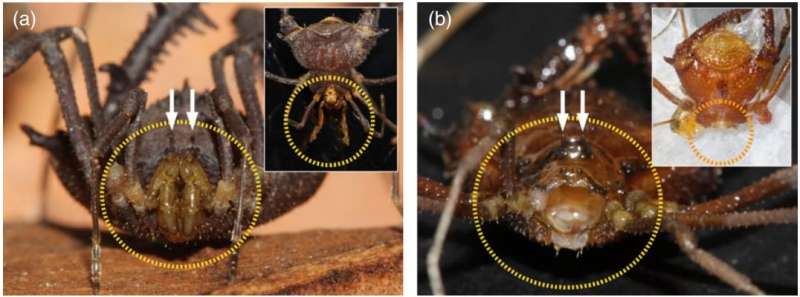(a) The harvestman Mischonyx cuspidatus alive, in frontal view. The chelicerae cannot be seen because they are hidden behind the pedipalps (dotted circle). Inset: Another individual in ventral view, showing the pedipalps and chelicerae (dotted circle); (b) M. cuspidatus in frontal view after being killed and its body contents consumed by the flatworm Cephaloflexa bergi. Pedipalps and chelicerae have been detached by the flatworm and therefore are missing (dotted circle) and the internal contents of the prey have been ingested by the flatworm. Inset: The same individual in ventral view, showing the absence of pedipalps and chelicerae (dotted circle). Arrows in both figures show the spines of the ocularium. Credit: Journal of Zoology (2018). DOI: 10.1111/jzo.12570
A trio of researchers with Universidade de São Paulo has documented evidence of flatworms and harvestmen engaging in battle in the forests of Brazil. In their paper published in the Journal of Zoology, M. S. Silva. R. H. Willemart and F. Carbayo describe what they observed in the wild and what they saw when they brought samples of the combatants into their lab.
There are a many types of flatworms, including planarians, parasitic flukes and tapeworms. In this research effort, the researchers were looking at Cephaloflexa bergi, a small flatworm that emits mucus as a means of catching prey. There are a lot of types of daddy long-leg spiders, too, one of which is the harvestman. Although not technically a spider, it has the long legs that most people identify with a group of spindly arachnids. Though not typically considered dangerous, it does have sharp spines on its legs. In their study, the researchers sought to uncover more about the interactions that occur between the two bugs in the forests of Brazil.
The researchers went into the forest and watched them interact, which generally meant fight. They discovered that the flatworms usually won such battles, which the team found somewhat surprising. To get a better handle on what occurred, the team collected several specimens of each and brought them into the lab for study.
The researchers report that the flatworms were the aggressors. A flatworm would approach a harvestman and whip the tip of its body at a leg, causing it to adhere via the mucus on its body. As the harvestman attempted to extricate itself, the flatworm would grab another leg. Sometimes, the flatworm would even hogtie the arachnid, gluing its legs together, or to the ground. In each case, the goal was clearly the same—disable the harvestman to the point that the flatworm could eat it. But the battle was not all one-sided, the researchers found. Some of the harvestmen managed to use their sharp spines to injure the flatworms. In some instances, they even managed to cut their attacker in half, allowing them to flee. The harvestmen also emitted chemicals normally used to ward off other predators, but they did not seem to have much of an impact on the flatworms.
More information: M. S. Silva et al. Sticky flatworms (Platyhelminthes) kill armored harvestmen (Arachnida, Opiliones) but are not immune to the prey′s weapons, Journal of Zoology (2018). DOI: 10.1111/jzo.12570
Abstract
Asking how prey respond to different species of predators helps understanding the repertoire of defenses prey exhibit. This approach may also add to the knowledge on the efficiency of prey′s defenses against each predator and allows studying the costs of being attacked by different predators. Here, we studied interactions between the predatory terrestrial flatworm Cephaloflexa bergi and the harvestman Mischonyx cuspidatus. The flatworm quickly strikes at the prey′s leg with its head, then crawls towards the prey′s body releasing mucus and thus subdues the harvestman. Harvestmen may release defensive chemicals and pinch the flatworm with spines on legs IV, sometimes cutting the predator in two pieces. We also experimentally assessed the benefits of harvestmen′ defense and the cost of being attacked by testing whether the chemical defense of the harvestmen is efficient against the flatworm and whether the harvestmen that had survived a flatworm attack would have their locomotion abilities hampered. Both hypotheses were corroborated. Previous studies on interactions between harvestmen and other predators, such as spiders and scorpions, had shown that defensive secretions and mechanical retaliation were seldom used and were often ineffective. Our results point to the exact opposite and suggest that different predators exert different selective pressures culminating in the array of defenses exhibited by the prey.
Journal information: Journal of Zoology
© 2018 Phys.org
























